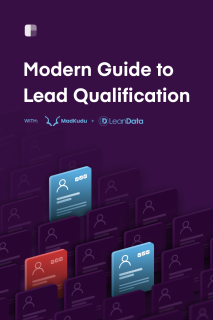Chapter 8
6 minutes
Right-size your lead routing
A young startup with three sales reps can get by with just a round robin, but that won't cut it once they start adding geographical sales territories and tiering their leads into SMB, Midmarket, and Enterprise.
Colin White, Clearbit's Head of Demand Generation, also points out that manual qualification and round robins can be slow and result in unbalanced distribution of leads, even in a small team with just two reps.
As a company's complexity increases, they need more help from people and tools to pull off smooth routing.
Benchmarks for lead routing systems
Here are some loose benchmarks to check how well-matched your routing system is with the rest of your resources and go-to-market strategy.

When are you ready for a lead routing platform?
You might ask, "But can't I just keep my routing rules in Salesforce forever?"
Yes, you can use Process Builder to route leads in Salesforce beyond a basic round robin. But as your company grows, you'll need more and more people to maintain the code and keep up with go-to-market changes. This can hold you back as you scale, because things can get very complicated, very quickly.
Routing two types of leads to two types of sales teams is manageable. But down the line, imagine that you have five different types of leads, multiplied by three different sales teams, multiplied by four types of marketing offers or campaigns. The permutations start getting unwieldy.
Routing automation tools make it easier to implement logic gates and change them on the fly. They let you route a lead based on any field value in Salesforce — a simple example is that if a record is tagged as an SMB and you want to send it to round robin for a certain pool of reps, it's easy to set that up. And much more.
Don Otvos, VP of Revenue Operations at LeanData — an end-to-end routing platform — says, "As you grow, you'll need to set up sales territories, split your organization, and have routing that aligns to those territories. You're not going to round-robin it to just anyone. That's where a tool helps, and that's the kind of sophistication you need to start thinking about as an organization is growing."
Companies tend to be ready for a routing tool when they:
- Reach complexity and tiering in their sales team (which tends to track with the 50-employee mark and a sales team of around 7)
- Have a clearly defined ICP and personas
- Have a lead scoring methodology in place
As soon as you're getting past the point of two or three logic checks on your routing, you should advance beyond Process Builder.
If you have one type of prospect going to one sales group, it's very simple to operate that through Process Builder in a round robin flow.
But once you want to optimize for the content type, or route to different groups, or take vacation into account, you're adding a few layers of logic that will make Process Builder unruly for you.

LeanData shares the story of Cybrary, a company with a too-small routing system. By automating their manual routing to better match their business maturity, they upgraded their prospects' experience with faster, smoother outreach.

Cybrary, a cybersecurity and IT workforce development platform (with a great name), was attracting a staggering 10,000 to 20,000 new leads per week.
Their routing system was not nearly robust enough to accommodate this volume. It all came down to one person whose job it was to manually assign leads to reps.
So reps were slow to reach out, and the bottleneck created a backlog that took nine months for the new head of sales development, Ryann Morrow, to work through and move leads along. She had to go into Salesforce, see which leads were assigned to which sales team members, figure out whether they'd been contacted, then reassign so reps would follow up.
Cybrary switched to an automated system and saw conversions increase right away. Prospects even started giving them compliments for reaching out so quickly.
Today, Cybrary uses a lead score to qualify a lead, then LeanData sends it to an SDR round robin pool. It assigns the lead to a rep, who gets a Slack notification. If the lead is "hot"—a demo request or business trial—the rep must reach out within 20 minutes or the lead gets reassigned.
Their conversions and performance improved across the board:
- 64% increase in completed product demos
- 45% more opportunities created
- 133% increase in new pipeline
- 38% growth in number of closed won opps
- 98% increase in revenue from closed won opps
In addition, Cybrary can now enforce SLAs with current customers.
Cybrary was being held back by their old lead routing system. Now that they have the right size shoes on, they're off to the races. (Sorry, we had to.)
Clearbit also moved on from routing with Salesforce's Process Builder to using a lead routing platform as our qualification got more complex. One dimension, for example, is the number and kind of sales teams: first, we used to send all leads to one SDR team for qualification, but now, we send leads to SDRs, BDRs, or AEs, depending on a number of fit and intent factors. Here's a refresher of this evolution:

In the "crawl" phase, we hustled — SDRs worked everyone who was a reasonable fit.
In the "walk" phase, we started focusing on quality. SDRs worked on high-fit, high-intent leads for better results; everyone else was warmed up by marketing.
The "run" phase, which we're in today, is about specialization and focus. We've diversified the sales team and trained them to specialize in helping certain types of leads. High-fit, high-intent "slam dunk" leads go straight to AEs to minimize friction. We route leads who show interest but are a less certain fit to SDRs, who find out more information and qualify the lead. That way, we preserve our most expensive resource: one-on-one time with an AE. For the high-fit leads that haven't shown intent, we use BDRs to educate and generate sales readiness.
Our routing platform helps us figure out which of the three teams to send a lead to, weighing a number of fit data points, intent data points, and information about marketing campaigns that captured the lead.

